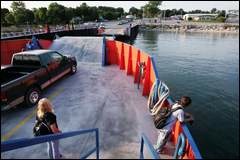
Originally published in The Blade on Sunday, September 2, 2007
BY RYAN E. SMITH
BLADE STAFF WRITER
MILAN, OHIO — It’s almost 8 a.m. and the sun is rising above Marblehead peninsula. The honking of four Canada geese flying overhead is interrupted by the puttering of a ferry approaching the shore.
Minutes later, three young figures walk slowly off the boat. One of them is Brian Terry, ready for his first day of school.
There’s not a yellow school bus on earth that could get Brian to class. Instead, he has to rely every morning on an orange-trimmed ferry named Shirley Irene to shuttle him 25 minutes across Lake Erie from his island home to the mainland.
Unless, of course, it’s winter and the lake has frozen over. Then he rides a small plane across. His 1999 Ford pick-up takes him the rest of the 27 miles to class at EHOVE Career Center in Milan, Ohio.
That’s what life is like when you’re a high school upperclassman from Kelleys Island, populated with 367 residents off the coast of Marblehead.
In this unusual school district — one of the smallest in the state — Brian, 17, is no ordinary member of the senior class. He’s the only member.

Brian has heard all the clever jokes before, but go ahead and get them out of your system.
Yes, he’s in a class by himself.
Yes, he’s the valedictorian. And the salutatorian.
Having a senior class of one or two students isn’t all that uncommon for this island. When one of Brian’s older brothers, Mike, graduated with five others last spring, it was the largest class in more than 50 years.
The microscopic student population isn’t something that bothers Brian, who joined the district three years ago when he started living year-round on the island where his parents, who are divorced, run businesses.
“It doesn’t really matter. I hang out with all the kids from all the different grades,” Brian said before his first day of high school classes Aug. 24.
“[My brother and I] always wanted to go to school here. We always thought it would be cool,” he said, noting that he’d already made friends on the island during the summers he spent there growing up.
There were some immediate differences, though, when he enrolled as a freshman. Instead of joining a system with hundreds of high school students, he entered one that now has 20 in the entire district, from kindergarten through 12th grade.
The school is an old brick structure sitting on the highest point of the island, which occupies less than five square miles. The original building has five large classrooms, and there’s an addition with a gymnasium, kitchen, and library. Pictures line the walls, smiling little kindergarteners mingling with teenagers.
Two teachers divvy up the high school and junior high students by subject area. Spanish is taught by distance learning using a TV monitor. Sometimes there are more computers in a room than students.
“We are kind of like public-funded home schooling,” said principal/superintendent Phil Thiede, who also is part-owner of a restaurant/bar on the island.
Compare that to EHOVE, a vocational school where Brian started taking classes last year. Juniors and seniors from Kelleys Island usually take classes there to give them more exposure to people their own age. The school has 740 students and a campus of seven buildings. In between classes, the halls are filled with bustling students and the sounds of lockers clanging shut. At lunchtime, the cafeteria is packed with everyone from jocks to Goths.
When Brian arrives for the first day of school, things have already started, as usual, because he is delayed by his transportation schedule. He has to check in at a welcome center, an attendance office, and then walk to another building where his first class, a study hall, is already winding down. Leaning back on a desk, he chats with the teacher and receives a welcome-back hug from another student.
In his next class, English, 20 other classmates settle into the room. Back on the island, he shared space with just a few others, and there were times when he was all by himself.
“In math classes, I was always alone,” he said. “I always had to know the answer when they called on me because I was the only one to call on.”
Then there’s the issue of dating. As his mother, Cindy Holmes, observed, “My middle son had a girl in his class and they dated, but there’s really no one up here for Brian.”
Outside of the classroom, his options were limited, too. He ran cross country as a freshman, but it didn’t affect the standings of any meet because there weren’t enough runners to score as a team.
To expand their horizons, Mr. Thiede, who spent 30 years in education outside of Sandusky, encourages juniors and seniors to take classes at EHOVE. Some, like Brian, take college courses at Bowling Green State University’s Firelands campus in Huron, too.
“The kids really need to have the experience of dealing with more students other than one or two who are their age over here,” Mr. Thiede said.
That’s where the ferry or plane comes in. The district pays close to $100,000 a year to transport its students to the mainland every day, then drive them to school via a taxi service if they need it. High property values that raise plenty of tax money for the district combined with a small student population makes it possible, Mr. Thiede said.
Students from Kelleys Island generally fare well in their new, larger surroundings, according to EHOVE Superintendent Sharon Mastroianni.
“I think there has been in the past some social adjustment, but like most kids, they adapt pretty quickly,” she said.
For Brian, who is easygoing and friendly, it wasn’t a hard transition. He came from a mainland background and already knew some students at EHOVE from years before.
“He fit in right away,” said Mike Laser, one of his instructors.
On some basic level, school is school and kids are kids. Like many students his age, Brian likes to joke with his friends, go to the mall, and pursue the quest for the perfect parking spot.
For the first day of high school classes this year, Brian blended into the crowd in jeans, a T-shirt, and an easy smile. Fortified with a Monster energy drink he picked up at a gas station on the way to school (after taking the ferry with the three members of the juniors class from Kelleys Island), he shared a certain optimism with his fellow students, not even whining that he was trading in sunny days on the island for government class and computer labs.
“I’m kind of excited for the first day,” said Brian, who is part of the school’s computer networking technician program and built his first computer around the age of 12.
Still, despite the relative anonymity of a large school, Brian is a marked man, and not just because of the Kelleys Island shirts he wears from his mom’s gift shop.
One teacher calls him “The Islander,” and Brian enjoys telling the more gullible students that he swims to the mainland every day and lives without electricity.
Commuting from an island complicates his life in other ways, too. Practices for the parliamentary procedure team often were held on nights when Brian could stay somewhere on the mainland (usually a friend or relative’s house) because he would miss the last ferry back home.
Then there are the less subtle reminders that things are different once you get off the island and around a lot of young people. Like when EHOVE students crammed into a large room to test the bridges they’d made out of newspaper and tape on the first day of school as a team-building exercise.
It was a bizarre, Survivor-like atmosphere: Culinary arts students in chef hats used kitchenware to bang plastic tubs like drums. Auto body students wore camouflage face paint. Cosmetology students marched around with disembodied mannequin heads.
Brian sat on the floor and took it all in.
He’s asked his friends from the mainland what it was like to go to a bigger school. They say he didn’t miss much, but it’s hard to know for sure, especially when confronted with a scene like this.
“It just seems like I feel like I missed out on some things when I was younger,” he said. “But I don’t know ... what.”
The lone senior on Kelleys Island heads for class on mainland
Brian Terry, the only senior from Kelleys Island, arrives for class at EHOVE Career Center in Milan, Ohio. (THE BLADE/DAVE ZAPOTOSKY)




Brian Terry, right, and Marie Mowrey, left, also a Kelleys Island student, take the ferry to Marblehead, Ohio, to get to classes every day. (THE BLADE/DAVE ZAPOTOSKY)


